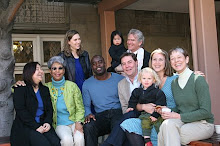Thanks for stopping by this blog! This is my first blog post. The purpose for this blog is to launch a dialogue with young adults in our congregation and the city of Oakland. Each day, as we drive through the Uptown neighborhood where our church is located, the signs of revitalization are everywhere…construction cranes, the doggie day care across the street, and the new Whole Foods down the street. As I observe all of this, I can’t help but ponder whether the revitalization of our neighborhood can be a harbinger of the revitalization of our faith community at First Presbyterian Church of Oakland, and of faith in the city of Oakland itself.
This causes me to ask the question, How can First Church be the place for a revitalization of religious community—with racial diversity, intellectual integrity, a passion for justice in Downtown Oakland, and deep love for God? When I say “revitalization”, I mean growing the church numerically as well as spiritually. These first few blogs will be focused on the “numbers” question. I am using the blog as a way to reach out and ask you to help this church increase the number of young adult members under 40 years old. This blog is a place for you to offer your suggestions, and ideas.
If you are already a member here, you know that First Presbyterian Church of Oakland is an exceptional place in Oakland. I am not aware of another “mainstream” Protestant church in the area that is made up of such a wide diversity of people. Nor do I know of a place that has such integrity about its engagement with all generations—from our children to our 90 yr. olds.
By “old mainstream Protestant churches”— I refer to American denominations with a long history, usually rooting themselves in an historical connection to the Protestant Reformation of Luther, Calvin, and Wesley. The Methodist, Presbyterian, Episcopal, and other “mainstream” Protestant denominations have been shrinking numerically for the last fifty years or so. There are lots of proposed explanations, but, truth is, we are a smaller part of American religious life than we used to be. The churches of these denominations tend to be predominantly older—that is, they do not have a lot of 20-40 yr. olds in them. However, there are some exceptions. Our aspiration is to be one of those exceptions—why not? Why not here?
The Larger Question: The question that I have as a 53 yr. old white male with an advanced degree, two grown children (a bit past typical college age) and a passion for this church and this city is this: How do we become that exception? Can we together develop a strategy that will evolve us into that exceptional church? I hope that this blog-space can be a place to explore some of the stumbling blocks in our way and some of the opportunities that are available to us and, hopefully, the genius to see the way ahead. This is meant to be a dialogue, and I hope to learn from your responses.
We want to maintain the core values of the church as best we can and be willing to entertain the idea that changes must occur to bring about growth among young adults under 40.
A Question to Begin With:
Tell me this—why do you think most people in our area, who are 20-40, have nothing to do with “organized religion?” How does our church, which offers core values that are consistent with young adults reach out to them?
In these first blog posts, I encourage you to help identify possible stumbling blocks to our growth. In the next few blogs I hope to write about the challenge of a “thinking faith”—including rationality but not making it an end in itself, the “west coast effect,” and other possible issues (that I hope you’ll raise too).
Grace and peace,
Rev. Chandler Stokes
Wednesday, May 21, 2008
Subscribe to:
Posts (Atom)

